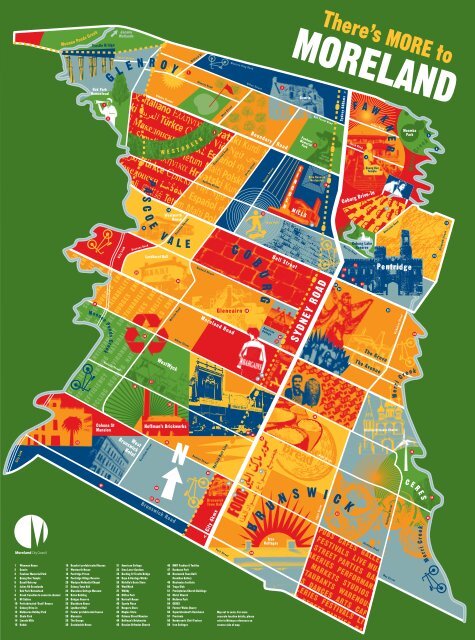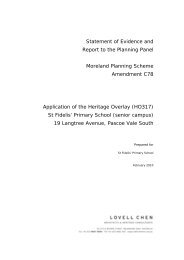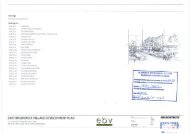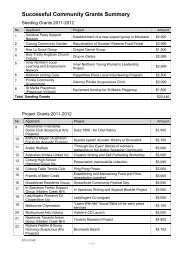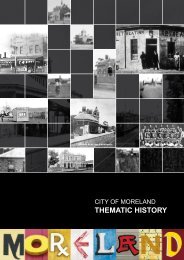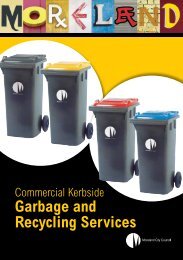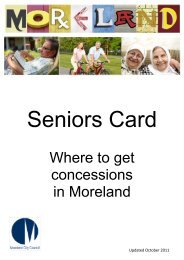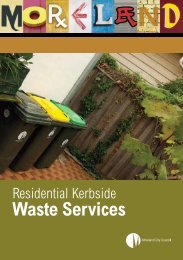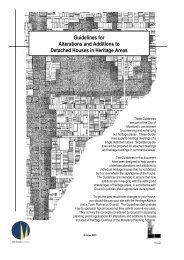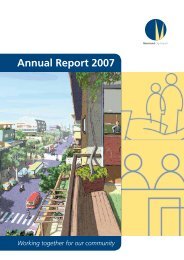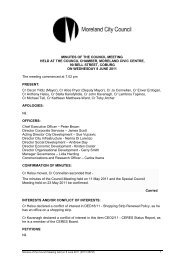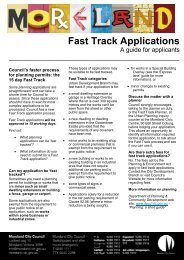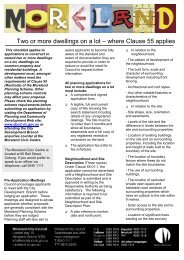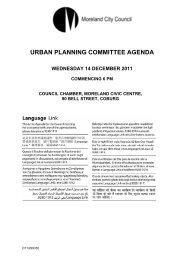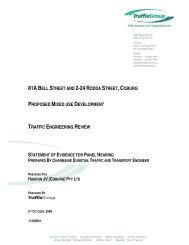Tourism Map_back.indd - Moreland City Council
Tourism Map_back.indd - Moreland City Council
Tourism Map_back.indd - Moreland City Council
Create successful ePaper yourself
Turn your PDF publications into a flip-book with our unique Google optimized e-Paper software.
����������������������������������������������<br />
����������������������������������������������<br />
����������������������������������������������<br />
����������������������������������������������<br />
�����������������������������������������<br />
�����������������������������������������<br />
����������������������������������������������<br />
����������������������������������������������<br />
�����������������������������������������<br />
�����������������������������������������<br />
����������������������������������������������<br />
����������������������������������������������<br />
�����������������������������������������<br />
�����������������������������������������<br />
����������������������������������������������<br />
����������������������������������������������<br />
�����������������������������������������<br />
�����������������������������������������<br />
����������������������������������������������<br />
����������������������������������������������<br />
�����������������������������������������<br />
�����������������������������������������<br />
����������������������������������������������<br />
����������������������������������������������<br />
�����������������������������������������<br />
�����������������������������������������<br />
��������������������<br />
���������<br />
�� �������������<br />
�� ������<br />
�� ���������������������<br />
�� ����������������<br />
�� ��������������<br />
�� �������������������<br />
�� ������������������<br />
�� ������������������������������������<br />
�� ���������<br />
��� �����������������������������<br />
��� ���������������<br />
��� ����������������������<br />
��� ����������<br />
��� �������������<br />
��� �����<br />
������������������<br />
��<br />
��������������<br />
��������<br />
���������<br />
��<br />
������������������<br />
�<br />
�������<br />
���������������<br />
���������<br />
�������<br />
��<br />
��� �����������������������������<br />
��� ���������������<br />
��� ����������������<br />
��� �������������������������<br />
��� ������������������������<br />
��� ����������������<br />
��� ������������������������<br />
��� ��������������<br />
��� ���������������<br />
��� ���������������<br />
��� ��������������<br />
��� ���������������������������<br />
��� ���������<br />
��� ����������<br />
��� �����������������<br />
�<br />
������<br />
��������<br />
�������������<br />
� � � � � � �<br />
���������<br />
������������<br />
��<br />
��<br />
����<br />
���������<br />
� � � �<br />
��<br />
���������������<br />
��������������<br />
� � � � � � � � �<br />
���������<br />
�����<br />
� � � � � � �<br />
��<br />
��������������<br />
�������������<br />
���������������<br />
�������������<br />
������������<br />
��������������<br />
��������������<br />
�����������<br />
���������������<br />
�����������������<br />
���������<br />
�������������<br />
����� ���������<br />
��� ����������������<br />
��� ������������������<br />
��� �������������������������<br />
��� ��������������������<br />
��� ����������������������<br />
��� ��������<br />
��� ������<br />
��� ������������<br />
��� ��������������<br />
��� ������������<br />
��� �������������<br />
��� ������������<br />
��� ���������������������<br />
��� ��������������������<br />
��� �����������������������<br />
��������������<br />
��<br />
��������<br />
��<br />
��������������������<br />
��<br />
��<br />
��<br />
��<br />
��<br />
��<br />
�<br />
�<br />
����������<br />
�������������<br />
��� �����������������������<br />
��� �������������<br />
��� ������������������� �<br />
� ����������������<br />
��� �������������������<br />
��� ����������<br />
��� �����������������������������<br />
��� �������������<br />
��� ������������<br />
��� �����<br />
��� �������������������<br />
��� ��������������������������<br />
��� ���������<br />
��� �������������������������<br />
��� �������������<br />
��<br />
�<br />
���������<br />
������������<br />
�����������������<br />
�����������<br />
��<br />
�������������<br />
���������������<br />
������������<br />
� � � � � �<br />
��<br />
��<br />
��<br />
��<br />
��<br />
��<br />
��<br />
���������������������������<br />
����������������������������������<br />
�������������������������������<br />
���������������������<br />
��<br />
��<br />
�������������<br />
����������<br />
��������<br />
�������<br />
��<br />
��<br />
��<br />
�<br />
�����������<br />
��<br />
�<br />
�<br />
�<br />
�<br />
�<br />
�<br />
������<br />
��������<br />
��������<br />
����<br />
�����������<br />
������<br />
���������<br />
������������<br />
����������<br />
�����������<br />
������������<br />
������������<br />
����������<br />
���������������<br />
�����������<br />
������������������������<br />
�����������������������<br />
����������������������<br />
�����������������������<br />
������������������<br />
�������������������������<br />
���������������������������<br />
���������������������������<br />
�����������������������������<br />
���������������������<br />
��������������<br />
��������������<br />
� � � � � � � � �<br />
����<br />
��������<br />
��<br />
��<br />
�<br />
��<br />
���������������<br />
��������<br />
���������������<br />
��<br />
��<br />
��<br />
����������������<br />
��<br />
��<br />
��<br />
�<br />
����������<br />
���������<br />
������<br />
�����������<br />
�������<br />
��<br />
� � � � � � �<br />
��<br />
��<br />
���������<br />
����������<br />
�������������<br />
�����������������������<br />
�������������<br />
��<br />
����������������<br />
����������<br />
����������������<br />
������<br />
����<br />
���������<br />
��<br />
�����������<br />
��<br />
� � � � �<br />
�����������<br />
��<br />
�<br />
��<br />
�����������<br />
��<br />
��<br />
�<br />
��<br />
����������������
You won’t find anywhere like <strong>Moreland</strong> in the<br />
whole of Melbourne. Take time to explore its<br />
secrets. You’ll be surprised.<br />
Just 4.5 kms from Melbourne’s CBD, with excellent public<br />
transport links to the city, <strong>Moreland</strong> combines the urban<br />
beat of café culture, contemporary arts and music, with<br />
green parks and meandering creeks.<br />
<strong>Moreland</strong>’s history includes indigenous and European<br />
settlement, as well as industrial boom and waves of<br />
migration. <strong>Moreland</strong> hosts more than 61 community<br />
festivals and celebrations each year and, in Sydney Road,<br />
you will find one of Melbourne’s most varied shopping<br />
and eating experiences.<br />
This map features some of our favourite places reflecting<br />
<strong>Moreland</strong>’s history and its multicultural community. We’re<br />
sure you will find other hidden treasures along the way.<br />
Some of the places mentioned in this leaflet are privately<br />
owned, particularly houses, and are not open to the public.<br />
We request that you respect the privacy of the owners.<br />
<strong>Council</strong> recognises Aboriginal people as the original<br />
custodians of the land now known as the <strong>City</strong> of<br />
<strong>Moreland</strong>. Wurundjeri people, part of the Woiworung<br />
group, traditionally used the rich resources of the region<br />
and its many waterways. The ‘Merri Merri’ creek was<br />
a meeting place for the Woiworung and three other<br />
cultural language groups, for social contact, ceremonies,<br />
marriage, trade and deciding issues of customary law.<br />
A More Sustainable Future<br />
CERES 54<br />
(Centre for Education and Research in Environmental Strategies)<br />
8 Lee Street, Brunswick East (Melways 30 B7)<br />
CERES focuses on environmental and social<br />
issues affecting urban areas. The site has displays<br />
and functional demonstrations on a range of<br />
environmental issues to show what can be<br />
achieved at household, community and global<br />
levels. These include energy generation, waste re-<br />
cycling, permaculture and ways to reduce impact<br />
on the environment. There are many community<br />
projects and opportunities to get involved as<br />
a volunteer. CERES has an active education<br />
programme for all ages.<br />
Check out the following and see the CERES website for more<br />
information and opening times: http://www.ceres.org.au/<br />
• Café (open 7 days/week)<br />
• Community gardens<br />
• Permaculture gardens<br />
• Origin EcoHouse<br />
• Origin Energy Generation System, including wind generation,<br />
solar power and photovoltaics<br />
• Animal farm<br />
• Permaculture and Bushfood nursery<br />
• Multicultural village (with African and Indian cultures represented)<br />
• Indonesian village<br />
• Comprehensive display of household composting systems<br />
• Several trails, such as the Wurundjeri Wander, the 2030 Trail, the<br />
Greenhouse Trail and the Waste Wise Trail<br />
• Vermiculture and worm farm enterprise recycling organic waste<br />
• Market garden next to the Harding Street trestle bridge is run by<br />
CERES and produces organic vegetables. Now the only market<br />
garden left on Merri Creek – there were lots, many farmed by<br />
Chinese. (Melways 30 A2)<br />
WestWyck 36<br />
492 Victoria St, Brunswick West (Melways 29 D7)<br />
WestWyck is a developing “eco-village” which re-uses the building<br />
and grounds of the former Brunswick West Primary School. The<br />
project is dedicated to sustainable development and good design.<br />
Key features include:<br />
• Re-cycled building materials;<br />
• Water management and conservation measures that include the<br />
removal of hard surfaces to allow water to permeate, maximised<br />
storage and use of roof water, recycling of grey water,<br />
minimisation of water discharge from the property through the<br />
use of storm water retaining reed beds which also protect the<br />
foundations of the building;<br />
• Two underground worm farms to treat all organic waste<br />
produced on site, including some toilet wastes and three<br />
transpiration beds to deal with liquid waste;<br />
• Energy efficiency achieved through site orientation, insulation,<br />
double glazing, solar/gas hot water systems, water and energy<br />
efficient appliances; and<br />
• Generation of renewable energy through photovoltaic cells.<br />
An informative website is worth a look:<br />
http://www.westwyck.com and a visit to CERES will help you to<br />
understand the technology being used at WestWyck.<br />
See also: Sustainable Energy Authority of Victoria<br />
www.seav.vic.gov.au<br />
Brunswick West sustainable house 30<br />
19 Murray Street, Brunswick West (Melways 29 C5)<br />
A 1929 Californian Bungalow retrofitted for energy and water<br />
efficiency including solar electricty, solar hot water, rainwater<br />
tanks and water recycling, set in a permaculture garden. It was the<br />
first grid connected solar house in Victoria. The family has cut its<br />
household mains water use to just 3 buckets a day!<br />
Contact: smcquire@bigpond.net.au<br />
RMIT University Fashion and Textiles Building 46<br />
25 Dawson Street, Brunswick<br />
(Melways 29 F8/9)<br />
Designed by H2o and Bates Smart<br />
Architects, the project is significant<br />
because of its environmentally<br />
responsive design. Initiatives include<br />
the western red cedar façade which<br />
provides passive solar temperature<br />
control through its double skin as<br />
well as reflecting the woven fabric<br />
of textiles.<br />
A super-short history of European<br />
settlement<br />
When land in <strong>Moreland</strong> was first sold by the Colonial NSW<br />
government in 1839 settlers purchased large blocks of many acres.<br />
Over the years these were split into smaller blocks, then smaller<br />
blocks again and sold off. Sydney Road, once a cart track, became<br />
the main route from Melbourne to Victoria’s goldfields with shops,<br />
churches, hotels and a mechanics institute already built by the late<br />
1860s. Pentridge Village was an important focus.<br />
Pentridge Village (Coburg) 19<br />
(Melways 17 H/J 11/12)<br />
Coburg was originally called Pentridge, a name<br />
which, to most Melburnians, means a notorious<br />
high security prison. This is a long way from the<br />
government’s original vision for Pentridge when<br />
they set aside land to create a village to serve<br />
surrounding communities. The Pentridge Village<br />
Reserve was marked out between (today’s) Sydney<br />
Road to the west and Coburg Cemetery (Melways<br />
18 B12) to the east (now in the <strong>City</strong> of Darebin).<br />
Pentridge Village Reserve is one of few left in Melbourne. The church<br />
and municipal reserve towards the NE of the Sydney Road and Bell<br />
Street intersection were built early in the village’s development. It<br />
has a number of civic buildings including the Uniting, Anglican and<br />
Roman Catholic Churches; Coburg Primary School; Coburg Town Hall<br />
and council offices. This is the only place in Victoria where churches of<br />
major denominations are side by side.<br />
The former Wesleyan Methodist Chapel in this complex is the<br />
oldest surviving Methodist church in Victoria. It was built 1849-50<br />
from local bluestone and imported sandstone.<br />
HM Prison Pentridge 18<br />
(Or the reason Pentridge became Coburg) (Melways 17 J11/12)<br />
Pentridge Village’s development was slow and there was plenty of<br />
land available for a prison. It was also close to Melbourne and had<br />
a good bluestone supply.<br />
The first prisoners arrived in 1850 and were locked in two rows of<br />
huts-on-wheels behind a four-feet-high stake fence. The idea was<br />
that this temporary prison could be wheeled to wherever labour<br />
was needed.<br />
A permanent prison, the largest in 19th century Victoria, was built<br />
between 1858-64. Daily life in this model prison was harsh. It was<br />
a life of hard labour, silence and isolation. Social contact was<br />
not allowed.<br />
Pentridge supplied most of the bluestone for early Melbourne<br />
and prisoners spent up to 10 hours a day locked in cramped,<br />
individual pens crushing the hard stone. At the Port Arthur<br />
convict settlement in Tasmania crushing bluestone was<br />
considered to be the worst punishment possible. At Pentridge<br />
it was an everyday task.<br />
After Pentridge was built the<br />
villagers, tired of the stigma of<br />
being associated with a gaol,<br />
tired of living with the sounds<br />
of prison life (warders firing at<br />
prisoners, a bell which rang every<br />
half hour), and tired of living<br />
in constant fear of (frequent)<br />
escapes – changed the name of<br />
the village to Coburg in honour<br />
of Queen Victoria’s husband<br />
Prince Albert, Duke of Saxe Coburg in Germany.<br />
When Melbourne Gaol closed in 1923 Pentridge became<br />
Melbourne’s main prison and the site for hangings. The<br />
remains of prisoners executed at Melbourne Gaol, including<br />
Ned Kelly, were re-buried at Pentridge. The last public hanging<br />
in Australia took place here in 1967 – Ronald Ryan.<br />
Although closed in 1997, Pentridge Prison presents an<br />
imposing reminder of the brutal regime that operated there<br />
for over 100 years. During its history, Pentridge also housed<br />
a women’s prison and children’s reformatory. Most of it<br />
survives intact. The site was sold in 1999 by the Victorian<br />
State Government and is now being privately developed into a<br />
residential, commercial and tourism precinct.<br />
Places linked with Pentridge Prison<br />
Prison warders had to live within earshot of the prison bell.<br />
The Bluestone Cottage at 82 Bell Street, Coburg, (Melways 17<br />
J12) was originally one of seven. It is now HQ of the Coburg<br />
Historical Society with a major Pentridge display area 22 .<br />
Arundel at 42 Ross Street, Coburg (Melways 17 H11) was a<br />
boarding house for warders run between 1896 and 1898 by<br />
the wife of Pentridge’s warder in charge of rosters.<br />
Coburg Lake Quarry (Melways 17 J10)<br />
Bluestone rock faces are a reminder of the time<br />
the area was used as a quarry for stone used to<br />
build the nearby Pentridge prison. Prisoners also<br />
planted the willows on the banks of the lake, to<br />
provide raw material for basket weaving.<br />
Bluestone bridges built by prisoners<br />
• Newlands Road Bridge over Merri Creek,<br />
built 1865 (Melways 17 K11)<br />
• Murray Road Bridge over Merri Creek, built<br />
1870 (Melways 18 A10/11)<br />
More Recreation and Retail Therapy<br />
Sydney Road<br />
Sydney Road did not start out as the buzzing thoroughfare it is<br />
today; it began as an access track to farming allotments. Then<br />
gold rush mania turned the road into the path to riches and<br />
things got busier. Substantial hotels and stores with supplies<br />
for the goldfields sprang up quickly.<br />
By the early twentieth century Sydney Road<br />
was one of the busiest in the city and, today,<br />
it is certainly the most exciting… think<br />
international bazaar; middle Eastern souk;<br />
belly-dancing, Mediterranean outdoor market;<br />
an international fashion show and, last but not<br />
least, a place you can find more bargains than<br />
you can imagine.<br />
Take the tram, make lots of stops, and savour<br />
the sounds, smells and tastes of this dynamic<br />
street – one minute you’re in Greece – take a<br />
few steps and you have arrived in Lebanon…<br />
another and you are in Morocco, Turkey, Italy,<br />
China, India … take time to explore; a round<br />
world trip without the air ticket!<br />
Look out for these retail landmarks:<br />
Bates Building 23<br />
400-404 Sydney Road, Coburg (Melways 29 G8)<br />
Built in 1866 for Henry Bates a carrier, the ground floor<br />
first included stables and small shops. Upstairs there was a<br />
roller skating rink, which became a dance hall in the 1930s<br />
displaying striking mural decorations of the Taj Mahal Dance<br />
Club (limited viewing, mainly in December).<br />
Brunswick Market 40<br />
1-9 Ballarat Street, Brunswick (Melways 29 G7)<br />
This former market, now converted into flats and houses, was<br />
Melbourne’s first self-service grocery store run by Geelong<br />
supermarket pioneer S E Dickens. Melbourne wasn’t ready and<br />
it closed in 1915. Today the site links to Sydney Road through<br />
Sparta Place, a pedestrian piazza which celebrates <strong>Moreland</strong>’s<br />
Greek ties and sister city relationship with Sparta. Lighting<br />
enhances the market buildings at night.<br />
Hooper’s Store 41<br />
463-475 Sydney Road, Brunswick (Melways 29 G7)<br />
Opened in 1908 Hooper & Co was a leading 19th century<br />
draper with Hoopers running it until 1935. Hooper’s Store is an<br />
American-style steel framed building designed by the architects<br />
of Melbourne’s Myer department store, HW and FB Tompkins.<br />
Recently taken over by Melbourne couturier Mariana Hardwick.<br />
Former <strong>Map</strong>les Store 42<br />
466 Sydney Road, Brunswick (Melways 29 G7)<br />
One of a group of five gothic style commercial buildings, it<br />
has been a bank, part of the <strong>Map</strong>les chain and now a Franco<br />
Cozzo furniture outlet.<br />
For more Sydney Road gems follow Historic Sydney Road:<br />
Brunswick and Coburg, a brochure by Brunswick Community<br />
History Group and Coburg Historical Society.<br />
Lygon Street<br />
The café culture in Lygon<br />
Street is hip and bohemian. It’s<br />
multicultural, it’s lively, it’s the<br />
place to be (seen). You’ll find<br />
patisseries and bakeries with<br />
treats from every country you<br />
can think of. There are also<br />
cafes, bars, fruit and health food<br />
shops and locally made gelati.<br />
More Bargains<br />
<strong>Moreland</strong> is the home of bargain shopping. Clothing, textiles,<br />
shoes, leather goods, food, furniture, manchester, sports,<br />
electrical… plan your tour by checking out these websites:<br />
Factory outlets in <strong>Moreland</strong>:<br />
http://www.moreland.vic.gov.au/business/factoryoutlets-fr.htm<br />
Shopping centres in <strong>Moreland</strong>:<br />
http://www.moreland.vic.gov.au/business/retailcentres-fr.htm<br />
Bargain Shopping website:<br />
http://www.bargainshopper.com.au<br />
More Parks and Open Spaces<br />
<strong>Moreland</strong> has a surprising diversity of open spaces, many built<br />
over former clay pits or quarries. The creeks offer major green<br />
respites from the built up areas and include recreation facilities,<br />
BBQs and public art. Excellent pedestrian and bike access.<br />
Moonee Ponds Creek<br />
Once a tranquil meandering chain of deep ponds and<br />
wetlands, but deemed by the former Melbourne Metropolitan<br />
Board of Works as ‘unstable’ and subject to flooding, the creek<br />
was re-aligned and partially concreted with the building of the<br />
Tullamarine Freeway. The junction of works is located just north<br />
of Ethel Street, Oak Park where the divergent engineering<br />
treatments are most obvious (Melways 16 G7) 8 .<br />
Jacana Retarding Basin, Glenroy<br />
(Melways 6 E12)<br />
A major wetlands site shared between<br />
<strong>Moreland</strong> and Hume with abundant birds and<br />
wildlife and flood control mechanisms with<br />
a sci-fi appearance. Some of the best views<br />
towards the Melbourne skyline. Access from Moonee Boulevard.<br />
There are unexpected hilly landscapes in the northwest reaches,<br />
including a huge timber trestle bridge (1924) cutting across Kingsford<br />
Smith Ulm Reserve (Melways 16 F7 & G7).<br />
Oak Park Reserve 7<br />
26 Josephine Street, Oak Park (Melways 16 G6)<br />
A small reserve with mature trees, part of the estate of the 1840<br />
homestead ‘Bell Vue Park’ owned by John Pascoe Fawkner. An oak<br />
tree, believed to be planted by Mrs Fawkner, is registered by the<br />
National Trust.<br />
Union Street, Brunswick West (Melways 29 B8/9)<br />
Significant crescent of remnant vegetation along creek, western end<br />
of Union Street.<br />
Merri Creek<br />
Interpretive signage from Fawkner to Brunswick.<br />
Moomba Park and Moomba rocks, Fawkner 5<br />
(Melways 7 J/K 11; 8 A11 & 12)<br />
Open grassy plains with long views <strong>back</strong> towards city<br />
skylines. Majestic basalt outcrop on escarpment<br />
Jukes Road Grasslands 6<br />
(Melways 18 A1 & 2; B1 & 2)<br />
Nationally and regionally significant remnant grassland species.<br />
Coburg Lake Reserve (Melways 17 J10)<br />
A major recreation area for people in the northern<br />
suburbs, renowned for swimming and picnic facilities<br />
from the early 20th century. See the fish ladder close<br />
to the Newlands Road Bridge, which enables fish to<br />
swim upstream.<br />
More open space…<br />
Westbreen Creek Parklands (Melways 17 A6-8)<br />
An undulating linear park, home to many species of birds and<br />
animals.<br />
Bain Reserve, Merlynston 10 (Melways 17 G6)<br />
Merlynston is <strong>Moreland</strong>’s secret village set around<br />
a green, Bain Reserve, and recent prize-winning<br />
boardwalk. Developer Stuart Bain envisaged<br />
Merlynston as the ‘Toorak of the North’ when<br />
he bought the land in 1919. Note the line of<br />
prefabricated ‘snail’ houses along Lorenson Avenue.<br />
Clifton Park, Brunswick 38 (Melways 29 E7-F7)<br />
<strong>Moreland</strong>’s festival park.<br />
Temple Park, Brunswick 50 (Melways 29 E9-F9)<br />
Home to Brunswick Trugo Club. Trugo, a mix of bowling and croquet,<br />
started out in the 1920s as a game played by railway workers in the<br />
Newport rail yards and has a loyal following in Victoria.<br />
Randazzo Park, Brunswick 47 (Melways 29 H8)<br />
Australian Institute of Landscape Architects award<br />
winning urban park (2002).<br />
Methven Park precinct, Brunswick East 53<br />
(Melways 29 K8)<br />
Development from farmland to basalt stone quarry<br />
to council tip to public park. Historically significant<br />
for elm avenues and original path pattern. Note<br />
nearby 32 Lord Street which served as a synagogue<br />
and Sabbath School between 1942-1987.<br />
More than a clothes line and a wine<br />
cask (Industrial <strong>Moreland</strong>)<br />
Did you know that Australians invented the clothes line and wine<br />
cask? <strong>Moreland</strong>’s claim to fame is that it is the home of brick veneer<br />
and the birthplace of the cream brick fashion of 1960s Melbourne –<br />
see the earliest experiment in the use of cream brick (from Hoffman’s)<br />
on the spire of the Presbyterian church in Sydney Road 51 .<br />
And there’s more… <strong>Moreland</strong> provided most of the bluestone for<br />
Melbourne from its quarries and most of the bricks for the 1880s<br />
building boom from its numerous brick works.<br />
<strong>Moreland</strong> used to be a major textile, clothing and footwear<br />
manufacturer in Australia but continues to feel the impact of<br />
reduction of tariff protection. Many former factories are being<br />
converted into apartments.<br />
Brick making and potteries<br />
<strong>Moreland</strong> is an area rich in clay suitable for brick making. In the early<br />
19th century, chimneys dominated the skyline and clay pits peppered<br />
the landscape. Today, the clay holes are filled in and Hoffman’s<br />
towering chimneys stand alone.<br />
Hoffman’s Brick and Pottery Works 44<br />
72-106 Dawson Street, Brunswick (Melways 29 E8)<br />
Hoffman’s, named after the German-designed Hoffman brick kiln,<br />
was the largest pottery in Victoria operating from 1870-1969.<br />
Hoffman’s use of steam brick presses marked the change from<br />
small to large-scale brick making in Australia. The brickwork’s vast<br />
output supplied Melbourne’s builders during the 1880s boom. Other<br />
products included pipes, roofing tiles, jelly moulds, ginger beer<br />
bottles and spittoons.<br />
You can see the chimneys and two remaining brick kilns from the<br />
street and Hoffman company cottages in Munro Street (Melways<br />
29 E8 & F8). The site has been re-developed with town houses and<br />
apartments and there are plans for restaurants, entertainment and an<br />
art gallery in the old Hoffman’s buildings.<br />
Two leaflets: Brickworks and Potteries Walk and Phillipstown History<br />
Walk by Brunswick Community History Group, are available from<br />
Brunswick Library.<br />
Clothing and More<br />
The extension of the railway line into Brunswick and Coburg was<br />
good for local business. New businesses included textiles, rope<br />
making, baking, can making, paper mills and engineering. You can<br />
see evidence of these industries all over <strong>Moreland</strong>. We have picked<br />
some highlights… look out for more.<br />
Lincoln Knitting Mills 14<br />
82-92 Gaffney Street through to Charles<br />
Street, Coburg (Melways 17 E10)<br />
When built in 1919 Lincoln Mills was<br />
on the edge of Melbourne- but not for<br />
long as the area around Gaffney Street<br />
became the heart of Coburg’s textile<br />
manufacturing. Other notable factories<br />
included Anderson’s hosiery and Kaora<br />
Weaving Mills. Lincoln Mills made sports<br />
coats, sweaters, hosiery, vests and<br />
underwear. Lincoln Mills closed in 1980.<br />
Kodak 15<br />
173-199 Elizabeth Street, Coburg (Melways 18 B8/9)<br />
Kodak initially operated in Abbotsford, then moved to Coburg after<br />
WW2. Prime Minister Sir Robert Menzies officially opened the new<br />
plant in 1961 when the Kodak empire was at the height of its global<br />
influence. Spread over 27 hectares the Coburg complex was one of<br />
nine major Kodak manufacturing plants worldwide. Kodak became<br />
a major local employer. Closed in 2004 mainly because of the impact<br />
of digital photography.<br />
Downs & Sons Rope and Cordage Works (also known as<br />
Sampson Cordage Works) 34<br />
64-72 Tinning Street and 7-9 Cassells Road, Brunswick (Melways 29 G5)<br />
Downs Cordage Works is the only surviving rope works in Brunswick.<br />
Established in 1888 by A.C.Downs, from Hull in England, the<br />
company is now called Donaghy’s Industries.<br />
Gas Retort House<br />
21 Hope Street, Brunswick (Melways 29 G6)<br />
The Brunswick Gas and Coke Company operated here between<br />
1891-1904 providing gas for the lighting of Brunswick’s streets.<br />
The site was later occupied by a procession of gas appliance<br />
manufacturers including the Lux Foundry and Chef. Of the<br />
original gasworks complex, only the retort house remains. It<br />
created gas by the firing of coal at high temperatures relying<br />
on the rail line for the transport of coal. Believed to be the last<br />
example of a retort house in Victoria.<br />
MacRobertson Liquorice Factory Chimney<br />
and Fire Tunnel Remains<br />
342-348 Victoria Street, Brunswick<br />
(Melways 29 G7)<br />
The octagonal brick chimney is a local landmark<br />
and summons memories of the liquorice aroma<br />
which once filled nearby streets. Part of the site is a<br />
chocolate factory. Breathe in!<br />
Henderson’s Shirt Factory 58<br />
337-339 Brunswick Road, Brunswick (Melways 29 F10)<br />
Hendersons was one of Brunswick’s earliest clothing manufacturers<br />
(1915-early 1970s).<br />
Living in <strong>Moreland</strong><br />
<strong>Moreland</strong> has examples of bluestone homes for the wealthy and<br />
the workers; of prefabricated ‘kit’ houses; of revolutionary public<br />
housing and of contemporary sustainable housing.<br />
Kit houses were assembled in both the19th and 20th century, an<br />
ingenious response to housing and materials shortages.<br />
Merlynston Snail Houses 10<br />
Lorenson Avenue, Coburg North (Melways 17 G6/7)<br />
Victorian Railways imported these pre-cut houses for<br />
workers from England when building materials were<br />
scarce in Australia after WW2. Merlynston has one<br />
of the largest remaining clusters of ‘snail houses’ in<br />
Victoria- along Lorenson Avenue. Some can also be found in Dale<br />
Ave, Pascoe Vale (Melways 17 B10).<br />
The Beaufort House, Pascoe Vale South 16<br />
(Melways 17 B12 & 29 B1)<br />
Made from metal sheeting panels and bolted<br />
together. Designed in 1946 by technical staff from<br />
the Beaufort Bomber plant at the Department of<br />
Aircraft Production at Fisherman’s Bend. Assembled<br />
by the Housing Commission for War Service veterans. See the<br />
remaining Beaufort houses at 17 Fontaine Street;15 & 21 Somali<br />
Street; 15 & 19 Vaux Street; 15 Moascar Street; 19,31 & 35 Gallipoli<br />
Parade; 7,15,17 & 27 Reynolds Parade Pascoe Vale South.<br />
Lyndhurst Hall 26<br />
44 Walhalla Street, Pascoe Vale South (Melways 29 C2)<br />
The story goes that auctioneer and merchant Edward de Carle<br />
imported this 2 storey prefabricated timber house in the 1850s. It<br />
was moved to Walhalla Street in the 1920s.<br />
The American Cottage 31<br />
21 Station Street, Coburg (Melways 29 G3)<br />
Abraham Tyler Thomson brought this cottage, including outbuildings,<br />
from America in the 1850s. Style is ‘Carpenter’s Gothic’.<br />
Myer House<br />
659 <strong>Moreland</strong> Road, Pascoe Vale South<br />
(Melways 28 K3)<br />
These houses with panels of steel, were made<br />
and marketed by Myer Emporium and Ansett.<br />
Manufactured after WW2 at the Commonwealth<br />
Aircraft Corporation at Fisherman’s Bend, Port Melbourne. This is the<br />
only one left in Coburg.<br />
Fowler Estate, Brunswick West 27<br />
(Melways 29 A/B4 & A/B5)<br />
Mr. T W Fowler of Werribee invented a way to cast<br />
concrete walls on a flat metal table – complete with<br />
window and door openings. The first houses built from<br />
these concrete slabs were at Fisherman’s Bend. The<br />
Housing Commission bought the rights to Fowler’s system, mechanised<br />
it and, in 1943, built concrete houses in Yarrabin Street, Wyall Street,<br />
Curtin Avenue and surrounding streets.<br />
Iron Cottages, Brunswick 59<br />
181-183, 187-189 Brunswick Road, Brunswick (Melways 29 H10)<br />
These unusual little cottages of state historical, technological and<br />
architectural significance are rare surviving examples of prefabricated<br />
houses which were imported from England in the gold rush period (1854).<br />
More Mansions<br />
<strong>Moreland</strong>’s wealthy nineteenth-century landowners built grand<br />
mansions for themselves and their families. You can see some of these<br />
today although they no longer sit in the middle of rolling estates.<br />
Wiseman House (formerly<br />
Sawbridgeworth) 1<br />
30 Widford Street, Glenroy<br />
(Melways 16 J2)<br />
Built for Arthur Wiseman in 1887-<br />
88, one of the promoters of the<br />
speculative Glenroy Land Company,<br />
which marketed its ventures as the<br />
‘Toorak of the North’. Later used as<br />
an infectious diseases hospital and<br />
girl’s home. In 1963 sold to the local<br />
Anglican congregation.<br />
Mt Sabine 9<br />
Lake Avenue, Pascoe Vale (Melways 17 A6)<br />
Now enveloped by Pascoe Vale Girls’ High School, this grand<br />
Edwardian house had been built by 1900. Named after Mt Sabine,<br />
the highest mountain in the Otway Ranges.<br />
Wentworth House 17<br />
22 Le Cateau Street, Pascoe Vale South (Melways 29 B1)<br />
One of Victoria’s oldest remaining houses. The La Rose Estate, on<br />
which this house stood, was one of the few large farms left in the<br />
1860s. It belonged to Melbourne doctor Farquhar McCrae who built<br />
La Rose farmhouse in 1841-42 (Wentworth House).<br />
Glencairn 28<br />
6 Craigrossie Avenue -3 Wattle Grove, Coburg<br />
(Melways 29 F3)<br />
Built in 1859-1861 for Scottish-born draper and<br />
merchant, Robert Mailer, this house is one of the<br />
first in a chain of farmhouses built along <strong>Moreland</strong><br />
Road. Around Glencairn you can see evidence of early bluestone<br />
construction in kerbs, gutters and <strong>back</strong> lanes.<br />
Whitby House 37<br />
28 Whitby Street, Brunswick West (Melways 29 D6)<br />
This house, built in 1848 with coach house and<br />
stables, was designed by Melbourne architect John<br />
Gill for merchant Edward Whitby. Now flats.<br />
Hartnett House 39<br />
117-123 Albion Street, Brunswick (Melways 29 J6)<br />
Originally owned by a carter, this house has been a Salvation Army<br />
Home, children’s shelter and, by 1906, was the Melbourne <strong>City</strong><br />
Mission Home, with Sister E Hartnett, a welfare worker, in charge.<br />
Mansion 43<br />
20 Cohuna Street, Brunswick West (Melways 29 C9)<br />
Built for engineer John Buncle who had a factory in North<br />
Melbourne. The house was later used as a maternity hospital and<br />
home for unmarried mothers. Now privately owned.<br />
Superintendent’s Residence (former) 56<br />
903 Park Street, Brunswick West (Melways 29 C10)<br />
Dr John Cade, who discovered that lithium could treat bi-polar<br />
disorder, lived here in the late 1950s – 60s. Built for Merchant James<br />
Adams in 1888, the house – called ‘Aldersyde’ - was bought by the<br />
state government for the Superintendents of the Mount Royal Home<br />
for the Aged.<br />
Prestonia 57<br />
357 Brunswick Road, Brunswick (Melways 29 E10)<br />
This local landmark was built for brick maker James Stroud using bricks<br />
from his own yard the ‘Norfolk and Egerton Brick and Tile Works’.<br />
And…another house worth mentioning…is Blackburn House<br />
25 , 16 Louisville Avenue, Pascoe Vale South and only because its<br />
creator, builder Joe Clift, used a brick veneer system he is said<br />
to have invented. The rest, for Melbourne at least, is history.<br />
The house was built for Maurice Blackburn, who had moved<br />
to Coburg after winning the Federal Seat of Bourke in 1934<br />
(Melways 29 B3)<br />
Take a walk along The Grove and The Avenue, Coburg (Melways 29,<br />
J/K3) to see grand Victorian and Edwardian houses.<br />
More Bluestone<br />
Bluestone (basalt) mining had a major impact on <strong>Moreland</strong>’s<br />
development. You will notice bluestone in the kerbs, roads, lanes,<br />
bridges and houses.<br />
You can see evidence of quarrying at the former<br />
Wales Quarry (Kirkdale St Park) 55 on Merri<br />
Creek, Brunswick (Melways 30 B8).<br />
Wales Quarry was the largest stone-producing<br />
quarry in Victoria from the 1920s until its closure<br />
in the late 1950s. The quarry was more than 50<br />
meters deep, dwarfing the banks of the adjacent Merri Creek.<br />
Aerial winches were used to haul skips up the steep slopes.<br />
Edward and Barkly Streets formed a track from Sydney Road<br />
to the stone quarries in Brunswick. The houses are mainly small<br />
timber and brick cottages and were lived in by workers in the<br />
quarries and brickworks.<br />
See well crafted bluestone workers’ cottages at:<br />
• 130 Barkly Street, Brunswick East, built in 1850. (Melways 29 J10)<br />
• 189-191 Edward Street, Brunswick (Melways 29 J9), built in<br />
the 1860’s by brothers and carters Henry and John Jenkin.<br />
Former Moran and Cato Store<br />
119 Lygon Street, Brunswick (Melways 29 J8)<br />
Next to the Jenkins brothers’ houses, tucked behind a Victorian corner<br />
shop, are two bluestone cottages, once the premises of Moran and<br />
Cato, a successful Melbourne grocery chain (1860-1969).<br />
Gowrie 2<br />
63-65 Gowrie Street, Glenroy (Melways 7 C1)<br />
A traditional Scottish laird-style house built by pastoralist James<br />
Robertson in 1855. Notable owners include jockey R Lewis who<br />
rode Phar Lap in the 1929 Melbourne Cup (he came 3rd).<br />
20 Anketell Street, Coburg (Melways 29 G1)<br />
A bluestone cottage from the 1850s once surrounded by a 20<br />
acre property.<br />
The Grange 29<br />
39 Belgrave Street, Coburg (Melways 29 K1)<br />
This house is one of the earliest surviving buildings in the<br />
Pentridge district and was built in 1863 for Peter Virtue, a<br />
Scottish farmer and Baptist Church Missionary. Virtue was a key<br />
figure in the move to close pubs at 6pm.<br />
Arts and Culture<br />
Festivals and events<br />
For up to date details check <strong>Moreland</strong>’s ‘What’s On’ website:<br />
http://www.moreland.vic.gov.au/news/whatson-fr.htm<br />
Brunswick Music Festival<br />
Held in March each year – local and international artists<br />
http://www.brunswickmusicfestival.com.au/<br />
2005 Sydney Road Street Party<br />
Held in February each year<br />
http://www.brunswickmusicfestival.com.au/<br />
Public art<br />
<strong>Moreland</strong> has some great art<br />
in public spaces. Check out the<br />
website: http://www.moreland.<br />
vic.gov.au/services/publicart-fr.htm<br />
Counihan Gallery in<br />
Brunswick Town Hall 48<br />
233 Sydney Road, Brunswick (Melways 29 G8)<br />
Named after artist Noel Counihan this gallery has<br />
a year-round program showcasing <strong>Moreland</strong>’s<br />
cultural diversity and featuring local and<br />
interstate exhibitions. Entry is free.<br />
http://www.moreland.vic.gov.au/services/<br />
counihangallery-fr.htm<br />
Mechanics Institute<br />
Performing Arts Centre 49<br />
270 Sydney Road, Brunswick (Melways 29 G8)<br />
Built in 1868 of local bricks and described by the National Trust<br />
as ‘interesting in primitive composition in Roman Renaissance<br />
style’ the Mechanics Institute has served as a school for illiterate<br />
children, a school for apprentices and a Free Lending Library.<br />
Currently a multi-purpose performing venue.<br />
http://www.moreland.vic.gov.au/services/mipac-fr.htm<br />
Literature and Film<br />
Watch closely… <strong>Moreland</strong> is famous as the setting for many<br />
Australian books and films. These include Death in Brunswick<br />
starring Sam Neill; Shane Maloney’s Murray Wheelan detective novels<br />
and TV films; Chopper the movie based on books by Mark Brandon<br />
“Chopper” Read; The Big Steal, a film starring Ben Mendelsohn and<br />
Claudia Karvan and The Castle starring Michael Caton.<br />
A Trip Along the Upfield Line<br />
Parkville, Brunswick, Coburg, Fawkner<br />
The Upfield Railway line was built in the 1880s to move heavy<br />
goods and to provide a public transport service for the area’s<br />
growing population. The railway had a big impact on the<br />
development of the areas through which it travels. The Upfield<br />
Line is important as a complete example of nineteenth century<br />
railway buildings and technology.<br />
Pick up a <strong>Moreland</strong> <strong>Map</strong>: Community Facilities, Transport<br />
and Open Space (available from <strong>Council</strong> Citizen Service<br />
Centres) catch the train, cycle or walk along the rail-side<br />
pathway and explore.<br />
Look out for:<br />
Footbridge – <strong>Moreland</strong> Station<br />
Gatekeeper’s Cabins – Brunswick Road, Barkly<br />
Street, Albert Street, Hope Street<br />
Gates – Park Street (north side), Brunswick<br />
Road, Barkly Street, Union Street, Dawson Street,<br />
Victoria Street, Hope Street, Albion Street,<br />
Tinning Street<br />
Goods Shed – Jewell Station<br />
Siding Tracks – Colebrook Street, between Dawson and Albert<br />
Streets (disused)<br />
Signal Boxes – Union Street, Victoria Street, <strong>Moreland</strong> Road,<br />
Munro Street<br />
Signal Masts, Station Buildings and Platforms – Jewell,<br />
Brunswick, Anstey, <strong>Moreland</strong>, Coburg<br />
Fawkner Memorial Park 3<br />
1187 Hume Highway, Fawner (Melways 17 F4)<br />
The railway passes through Fawkner Memorial Park<br />
which has an Old Pioneers section that contains the<br />
graves of some of early Melbourne’s most prominent<br />
people, including John Batman. Their graves were<br />
relocated from the old Victoria Market Cemetery<br />
in 1922. A restored mortuary carriage reveals how<br />
coffins were transported to the cemetery before car<br />
ownership became widespread.<br />
<strong>Moreland</strong> Railway Station surrounds and signal box<br />
(Melways 29 G4)<br />
The streets around <strong>Moreland</strong> Railway Station show just how<br />
influential the railway was in encouraging sub division of<br />
large land blocks into smaller ones. You can see rows of small,<br />
detached houses along Station Street and two-storey terraces<br />
in <strong>Moreland</strong> Road. In Cameron Street the trees include palms,<br />
a typical 19th century railway choice. At 2A Station Street,<br />
check out the Ilma Lever Garden Centre 32 (Melways 29<br />
G3), a garden for the use of people with disabilities and a<br />
retail nursery.<br />
<strong>Moreland</strong>’s signal box controlled the sidings to local industries<br />
Thomas War and Company Free Stores, The <strong>Moreland</strong> Timber<br />
Company and Brunswick Plaster Mills. It is unique as it contains rare<br />
nineteenth-century railway technology.<br />
Former Melville’s Grain Store 35 1-7, 9-17<br />
Colebrook Street, Brunswick (Melways 29 G5)<br />
Wool and grain merchant Donald Melville<br />
built these magnificent bluestone stores in<br />
1887. Sidings from the railway lead directly<br />
into the buildings.<br />
Jewell Railway Station (Melways 29 G9)<br />
Built in 1888 and originally called South Brunswick, this red brick and<br />
bluestone station was named after the politician Hon J R Jewell in 1954.<br />
Private sidings were built for Hoffman’s Brickworks and Cornwall’s<br />
Potteries. Get off at this station to access Sydney Road’s shops, cafés etc.<br />
More to Do in <strong>Moreland</strong><br />
More swimming pools<br />
Coburg Leisure Centre (Melways 17 J12)<br />
Coburg Olympic Swimming Pool (Melways 17 K10)<br />
Fawkner (Melways 17 J2)<br />
Pascoe Vale (Melways 17 B9)<br />
Oak Park (Melways 16 H7)<br />
Brunswick Baths (Melways 29 G8) – Built in 1913-14 and once<br />
regarded as the finest in Australia with claims that water quality was<br />
superior to Melbourne’s drinking water. The baths also provided<br />
facilities for the public to take a wash! After the 1927-29 renovations<br />
the Baths were used for the Victorian swimming championships and<br />
were proposed for use in the 1956 Olympics.<br />
More movies<br />
Coburg Triple Drive-In Cinema 11<br />
155 Newlands Road, Coburg (Melways 17 J7 & K7)<br />
http://www.villagecinemas.com.au/cinema/cinema_42.htm<br />
Melbourne’s last operating drive-in cinema opened in November<br />
1965. Because it was so close to Pentridge Prison, cinema-goers<br />
were sometimes asked to wind up windows and lock car doors as<br />
escapees fled along the creek behind the screen.<br />
More places to camp<br />
Melbourne’s Holiday Park 12<br />
265 Elizabeth Street, Coburg (Melways 18 C7)<br />
The only caravan and camping park in the inner city and the closest to<br />
the CBD. It has cabins and sites for tents, caravans and motor homes.<br />
More for Bike Riders<br />
<strong>Moreland</strong> has a great network of traffic-free bike tracks and we are<br />
working to create even more.<br />
Merri Creek (Melways 7 J11-30 C10)<br />
Moonee Ponds Creek (Melways 29 B9 – 6 E11)<br />
Upfield Railway line path (Melways 17 G6 – 29 G10)<br />
Western Ring Road Path (Melways 7 J11- 6 E11)<br />
Capital <strong>City</strong> Trail (Melways 29 J10- 30 B11)<br />
More worship<br />
<strong>Moreland</strong> has a high rate of religious worship across diverse faiths<br />
with churches, temples and mosques across the city, including …<br />
Quang Duc Monastery 4<br />
105 Lynch Road, Fawkner (Melways17 H/J4)<br />
This temple and welfare centre were built over a<br />
former school site in 1997.<br />
Former Wesleyan Church 20<br />
340-346 Sydney Road, Brunswick (Melways 29 G8)<br />
Built in 1872 to a design by Percy Oakden, features polychrome<br />
brickwork from local kilns of John Glew.<br />
Christ Church 52<br />
10 Glenlyon Road, Brunswick (Melways 29 G8)<br />
The design of this church, built between 1857-1875 in the style of an<br />
Italian country villa, is very rare in Victoria.<br />
Former Presbyterian Church Buildings 51<br />
212 Sydney Road, Brunswick (Melways 29 G9)<br />
Two churches on one site built in 1865 and in 1895. The cream brick<br />
of the bluestone church spire is unique.<br />
Russian Orthodox Church 54<br />
1-7 Albion Street, Brunswick East (Melways 30 B6)<br />
Church and associated community hall<br />
and facilities.<br />
More Famous People<br />
Pioneer and early settler John Batman (1801-1839) was one of<br />
Melbourne’s founders. He is buried in Fawkner Cemetery. Ironic as<br />
Fawkner was Batman’s arch rival in the race to settle the city first – in<br />
the end they decided there was enough land for everyone.<br />
John Pascoe Fawkner (1792-1869) pioneer, politician and<br />
co-founder of Melbourne. Fawkner owned one of the largest<br />
farms in the area. His farmhouse, Belle Vue Park, is now Oak<br />
Park Homestead 7 and much altered from the original home<br />
(Melways 16 G6). Fawkner lived here between 1840 and 1855<br />
until he moved to Collingwood then returned at weekends until<br />
his death in 1869. He had stables, a barn, blacksmith shop and<br />
workers’ cottages as well as vast fruit orchards. (Homestead site<br />
is at 7 Oak Park Court and stables at 9 Oak Park Court, Oak<br />
Park). War-time Prime Minister John Curtin (1885-1945) lived in<br />
Brunswick from 1898 to 1917. Curtin went to St Ambrose’s School<br />
and, as a boy, worked in one of the brickworks. He was a key figure<br />
in the fight against conscription, which used St Ambrose’s Church<br />
Hall as its headquarters. He also played for Brunswick Football Club.<br />
William Thomas (1791-1867) Protector of Aborigines once lived in<br />
Coburg and Brunswick, including the site of today’s Bush Reserve.<br />
More Information<br />
Transport<br />
Trains, trams and buses:<br />
Tel: 131 6381/TTY 9619 2727<br />
www.metlinkmelbourne.com.au<br />
People with disabilities<br />
<strong>Moreland</strong> Equity and Access Officer (03) 9240 1225<br />
Local History<br />
• Brunswick Community History Group Inc (03) 9378 1194<br />
brunswickchg@yahoo.com.au<br />
• Coburg Historical Society and Bluestone Cottage Museum 22 ,<br />
82 Bell Street, Coburg 3058: Museum, books and leaflets on Coburg.<br />
http://members.optushome.com.au/leburch/<br />
Libraries<br />
• Glenroy (Melways 16 G3)<br />
• Fawkner (Melways 17 J2)<br />
• Coburg (Melways 29 H1)<br />
• Campbell Turner – Brunswick West (Melways 29 D4)<br />
• Brunswick (Melways 29 G8)<br />
Aboriginal History<br />
• Aboriginal Affairs Victoria http://www.dvc.vic.gov.au/aav.htm<br />
• Koori Heritage Trust http://www.koorieheritagetrust.com<br />
• Reconciliation Victoria http://www.reconciliationvic.org.au<br />
• Victorian Aboriginal Education Association Inc.<br />
http://www.vaeai.org.au<br />
Further information<br />
• CERES www.ceres.org.au<br />
• Fawkner Memorial Park: www.fcmp.com.au<br />
• Ilma Lever Garden Centre (Melways 29G3) Tel: (03) 9386 4241<br />
• Melbourne Holiday Park http://www.big4melb.com<br />
• <strong>Moreland</strong> Parks<br />
http://www.moreland.vic.gov.au/services/1parksearch-fr.htm<br />
• Quang Duc Monastery www.quangduc.com<br />
• Sydney Road www.sydneyroad.com.au<br />
• The Trugo Association of Victoria:<br />
http://home.vicnet.net.au/~vtrugo/title.htm<br />
• Westwyck www.westwyck.com<br />
Further details of community facilities, transport and open space<br />
are available on a <strong>Moreland</strong> <strong>Map</strong>, available from <strong>Council</strong> Citizens<br />
Service Centres.<br />
ACKNOWLEDGEMENTS<br />
• Broome, Richard 1987 (& 2001)<br />
Coburg – Between Two Creeks, Lothian<br />
Publishing Company, Vic<br />
• Penrose, Helen (ed) 1994 Brunswick:<br />
one history, many voices, South<br />
Melbourne Press, Vic<br />
• Chris Johnston, Context Pty Ltd<br />
• David Wixted, heritage ALLIANCE<br />
• Laurie Burchell,<br />
Coburg Historical Society<br />
• Pat Burchell, Coburg Community<br />
Information Centre<br />
• The National Trust (Victoria)<br />
• Text concept – Jackie Donkin<br />
• <strong>Map</strong> design and production –<br />
Mono Design<br />
There’s MORE to<br />
MORELAND<br />
Important note to reader. This publication is produced by<br />
<strong>Moreland</strong> <strong>City</strong> <strong>Council</strong>. <strong>Council</strong> provides this publication for<br />
information and communication purposes only and takes no<br />
responsibility for errors or omissions or for actions based on this<br />
information. Although <strong>Council</strong> provides this publication for the<br />
placement of information, advice and events, no claim is made<br />
by <strong>Council</strong> as to the accuracuy or authenticity of the content<br />
and <strong>Council</strong> does not accept any liability to any person for that<br />
content (or use of that content) provided or incorporated in it<br />
by reference. Copyright of materials contained within resides<br />
with <strong>Council</strong>. Apart from fair dealing for the purpose of<br />
private study, research, criticism or review, as permitted under<br />
the copyright legislation, no part may be reproduced or reused<br />
for any commercial purposes whatsoever. Information about<br />
events is correct at the time of printing. Changes may occur.<br />
Strategic Planning Unit. ©2005 <strong>Moreland</strong> <strong>City</strong> <strong>Council</strong>. MOR 04-109


